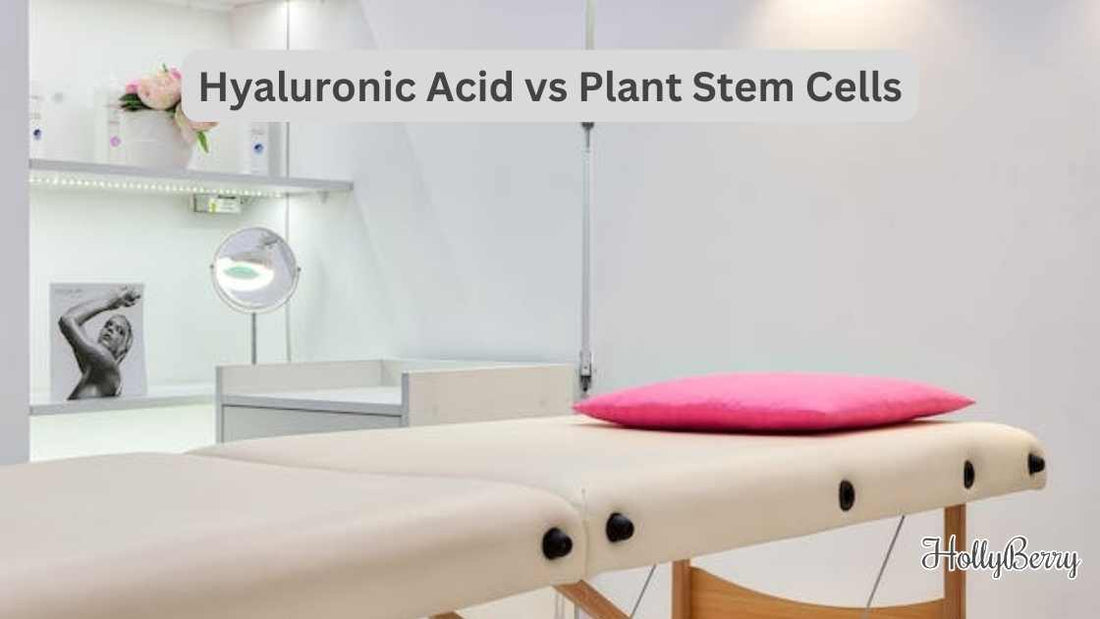
Hyaluronic Acid vs Plant Stem Cells
Share
Evaluating Skincare Efficacy

Hyaluronic acid, a substance naturally found in the human body, is a critical component in various biological processes, such as cellular signaling, inflammation modulation, and tissue hydration.
Due to its ability to retain moisture, it plays a crucial role in maintaining skin hydration and elasticity, making it a popular ingredient in skincare and anti-ageing products.
Moreover, its influence extends to regenerative medicine, where its properties are harnessed to facilitate wound healing and tissue repair by promoting cell proliferation and migration.
In parallel, the application of plant stem cells in cosmeceuticals has been gaining attention for their potential to protect the skin from oxidative stress and to improve signs of ageing.
While different from human stem cells, plant stem cells contain high concentrations of antioxidants which help in defending against environmental damage and reducing inflammation.
The intersection of hyaluronic acid and plant stem cells in skincare represents a confluence of hydration, protection, and rejuvenation.
Each provides unique benefits: hyaluronic acid acts as a powerful humectant and signaling molecule that can stimulate human stem cells to repair damaged tissues and moderate inflammatory responses; plant stem cells offer a protective effect against external aggressors that contribute to ageing.
When considering their use in regenerative medicine and anti-ageing treatments, examining the synergy between hyaluronic acid and plant stem cells could lead to innovative strategies for skin care and therapeutic interventions.
Hyaluronic Acid: Composition and Medical Applications
Hyaluronic acid, frequently found in medical and cosmetic products, is vital for tissue hydration and regeneration. Its multiple forms, from high to low molecular weight, cater to different therapeutic and aesthetic needs.
Biosynthesis and Regulation
Hyaluronic acid (HA), also known as hyaluronan, is a naturally occurring polysaccharide synthesised by various cells in the body, including keratinocytes. The biosynthesis process is regulated by enzymes known as hyaluronidases, and its production is integral to several bodily functions.
Biocompatible and biodegradable, HA plays a crucial role in wound healing, promoting angiogenesis and facilitating tissue repair.
Hyaluronic Acid in Clinical Trials and Therapy
Clinical applications of hyaluronic acid have expanded significantly with its biocompatibility and regenerative properties. In osteoarthritis, HA injections alleviate joint pain by providing lubrication.
Moreover, studies show alginate and HA-based hydrogels promote regeneration in tissue engineering. Its antioxidant properties also make it a valuable component in drugs, contributing to its widespread use in trials targeting various conditions.
Hyaluronic Acid and Aging
With age, the molecular size and concentration of native HA in the skin decrease, leading to reduced hydration and elasticity. Low molecular weight hyaluronic acid is often used in cosmetics for its ability to penetrate the skin and provide hydration.
Conversely, high molecular weight HA is favoured for its ability to form hydrogels that support the skin structure and have long-lasting effects. CD44, a cell surface glycoprotein, assists in HA binding, which is essential for skin repair and combating signs of aging.
Plant Stem Cells and Their Role in Regeneration
Plant stem cells are critical for the regeneration of tissues and organs due to their undifferentiated nature and ability to transform into multiple cell types.
These cells are predominantly found in the meristematic tissues of plants, and through differentiation, contribute to the plant's growth and repair.
Stem Cell Therapy and Tissue Engineering
In the context of tissue engineering, plant stem cells are not directly used; rather, the principles of regeneration in plant stem cells inspire advancements in stem cell therapy.
Osteoarthritis, a condition often requiring tissue reconstruction, benefits from the research into mesenchymal stem cells derived from bone marrow or adipose tissue.
Additionally, these stem cells have been studied for their role in not only tissue repair but potentially in managing conditions such as breast cancer owing to their influence on tumour cells and cancer progression.
The controlled differentiation of these cells is a pivotal aspect of tissue engineering, influenced by signals such as Wnt and Notch pathways.
Extracellular Matrix and Stem Cells
The extracellular matrix (ECM) is a critical component in the cellular environment, providing structural and functional support to cells. It plays a significant role in stem cell behaviour, particularly in their migration, proliferation, and differentiation processes.
Fibroblasts, which are a type of cell found within the ECM, secrete various factors that influence stem cell activity.
Research into the ECM has proven pivotal in understanding how stem cells can be manipulated in a laboratory setting, improving outcomes for stem cell therapy.
Plant Stem Cells in Anti-Aging Cosmetics
The paracrine secretion of growth factors and cytokines by plant stem cells has been utilised in the cosmetics industry to develop anti-aging products. These products aim to replicate the regenerative capacity of plant stem cells, albeit indirectly, by promoting the health of the skin’s own cells such as fibroblasts and keratinocytes.
Though plant stem cells themselves are not incorporated into the skin, their derived compounds are used to encourage the rejuvenation and protection of the skin’s extracellular matrix, potentially alleviating signs of aging.
